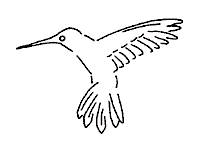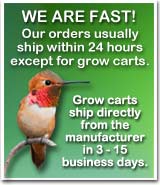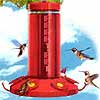Hummingbirds in North America
Page 1 - Information about hummingbirds
 - 2 - 3 - 4
HOMEMADE NECTAR RECIPE FOR HUMMINGBIRD FEEDERS:
 
Boil 1 part granulated sugar
to 4 parts water.
Example: 1/4 cup of sugar
to 1 cup water
Be sure to let it cool before pouring
into hummingbird feeder.
EXPERIENCE SAYS: - You do not need to add red food coloring to the sugar water solution. Never use honey to replace the sugar in your hummingbird feeders. Honey can spoil and develop a fungus that can be fatal to hummingbirds.
WHEN SHOULD WE PUT UP OUR HUMMINGBIRD FEEDERS IN THE SPRING?
We are not able to supply you with a personalized date for placing your feeders up in the spring. The best answer may come from an Audubon Society close to your location. We do keep a chart of spring arrival dates from our visitors and you are welcome to view it and add your sightings. Hummingbirds - Spring Arrival Dates
WHEN SHOULD WE TAKE DOWN OUR HUMMINGBIRD FEEDERS IN THE FALL?
Leaving your hummingbird feeders up will not stop the hummingbirds from migrating. They will begin moving south as early as July but it will take several months for the birds to begin to reach the southern U.S. and they can use your feeders during the trip. Remember, they eat lots of protein in their diets too and that doesn't come from sugar feeders. They need insects! Shortened days, not lack of food, will tell the hummingbirds when to begin their journey. Leave the feeders up at least three weeks after seeing your last bird. This will help migrating birds that pass through your area.
It is important to leave your feeders up and full. Migrating birds need all the quick and easy nourishment they can find to sustain the incredible energy demands of migration. It is vital that hummingbirds fatten up for their extended trips, particularly those crossing the Gulf of Mexico. During fall migration, hummingbirds at the Texas coast are trying to increase their fat reserves for the depleting journey across the Gulf of Mexico. Long before they reach our coast they have traveled long-used paths south across the states. For several weeks after your "regular" summer hummingbirds have left your flowers and feeders, migrating birds could be quickly passing through your gardens unnoticed. Leaving your feeders up for at least three weeks after seeing your last hummingbird is a typical rule of thumb. We always get reports of very late migrants and I like to think that enough folks are leaving feeders up across the country!
 CLICK HERE to locate your Audubon Society. They are well versed in rare sightings and can help you identify any unusual wild birds. They may also have state lists of birds to guide you and/or they can direct you to the best field guides for your specific area. CLICK HERE to locate your Audubon Society. They are well versed in rare sightings and can help you identify any unusual wild birds. They may also have state lists of birds to guide you and/or they can direct you to the best field guides for your specific area.
It is a great idea to keep your own journal of seasonal events such as the return of hummingbirds. BIRDS-N-GARDEN.COM provides a Spring Arrival Chart at the web site that tabulates e-mailed entries from visitors to the web site. We also have a Free Printables page that includes garden journal pages.
PROBLEMS WITH AGGRESSIVE HUMMINGBIRDS
Certain hummingbirds, especially males, will defend their source of food. Your feeder may become a battle ground.
There is nothing you can do to change
this behavior in hummingbirds.
It is an important survival trait.
Since we can't change the hummingbirds, we have to search for other solutions. Add extra feeders, out of sight of each other and at least 30 feet away. This will give the other hummingbirds a better chance of getting a meal. If you have more than five hummingbirds, they will probably share feeders that are placed closer together.
PROBLEMS WITH ANTS, BEES AND WASPS:
ANTS:
The product that works for me to discourage ants is an inexpensive ant moat that hangs above the hummingbird feeders.
Another alternative is to slather petroleum jelly over the pole from which the feeder hangs.
BEES AND WASPS:
 Bees and wasps are a very big problem in my backyard. I choose a feeder with bee guard cages around the feeding tube. These cages keep the bees and wasps from reaching the source of sugar. If you avoid spilling any sugar water when you hang your feeder, the bees will not find it rewarding to hang around. I carry my watering can with me. After hanging the feeder, I rinse the whole feeder with fresh water. Try to avoid a windy location.
Bees and wasps are a very big problem in my backyard. I choose a feeder with bee guard cages around the feeding tube. These cages keep the bees and wasps from reaching the source of sugar. If you avoid spilling any sugar water when you hang your feeder, the bees will not find it rewarding to hang around. I carry my watering can with me. After hanging the feeder, I rinse the whole feeder with fresh water. Try to avoid a windy location.
A weaker sugar water solution may help. Try using a 5 to 1 ratio instead of a 4 to 1 ratio. Placing your feeder in a shady location may not attract as many bees as a sunny spot will.
Wasps don't like getting sprayed with the hose. Sit down with a cup of coffee (oops, I mean tea!) or a glass of lemonade and just pester them for a few minutes until they move elsewhere!!!
FEEDER PLACEMENT CONSIDERATIONS:
- Get your feeder noticed. Initially, place your feeder in the best place to be seen! You can move it after the hummingbirds begin to arrive.
- In warm weather be sure to look for a shady location.
- Large numbers of birds will accept a busy feeding station and use feeders that are grouped.
- If you only have a few birds and they are very aggressive, place each feeder at least 30 feet apart. I prefer to hide them from each other by placing them around different sides of my home. This will keep confrontations to a minimum.5. Keep feeders within 15 feet of shelter for the birds. This means tall trees with plenty of leaves or a dense vine, etc.
CLEANING AND MAINTENANCE:
- Keep your sugar water fresh.
- Replace the feeder solution every 2 days in very hot weather.
- Wash out the feeder with very hot water. You can create you own cleaning solution by adding a small amount of vinegar or chlorine bleach to the water.
- Rinse, rinse, rinse.
- Ask a friend or neighbor to replace your homemade nectar if you are away. Be as consistent as you can but don't stress-out over it. I'm sure you have other sources of food in your area or the hummingbirds probably wouldn't be there in the first place!
- Having trouble washing the feeder? Do you have black spots inside that are too stubborn for normal cleaning? Pour a little uncooked rice into the feeder along with the cleansing solution and shake that feeder clean!
- Rinse, rinse and rinse some more.
WHO ELSE VISITS HUMMINGBIRD FEEDERS? | orioles
house finches
woodpeckers
warblers
mockingbirds
jays
chickadees
buntings
wrens
| lizards
raccoons
squirrels
opossums
bats
foxes |
Information on Hummingbirds (index of pages):
1. Hummingbird Feeders - you are here
2. Hummingbirds - General Information
3. More Migration Information
4. Hummingbirds - FAQ
5. Hummingbird Books
More Hummingbird Pages:
- Hummingbirds - Spring Arrival Dates
- Gardening to Attract Hummingbirds, Butterflies, etc.
- Hummingbird Crafts
|

| ![]()




